To celebrate the publication of the highly anticipated Atlas Obscura, we’re featuring the strangest of the world’s hidden wonders every day this week, excerpted from the book. Beware, these posts may inspire extreme, incurable wanderlust.
You’ve been warned.
Now, let’s get spiritual.
1. Trinity Church
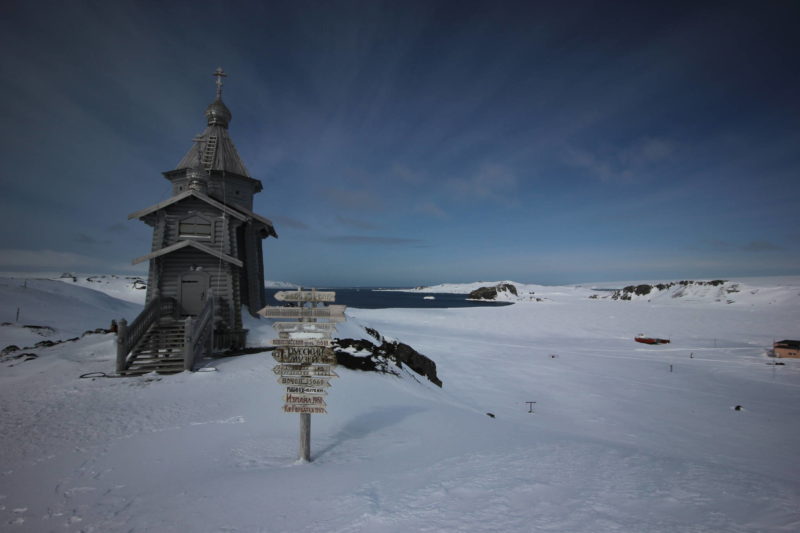
BELLINGSHAUSEN STATION, KING GEORGE ISLAND, ANTARCTICA
When it comes to unique weddings, it’s hard to beat the union of Chilean Antarctic researcher Eduardo Aliaga Ilabaca and Russian scientist Angelina Zhuldybina. In January 2007, the couple donned their formal wear, walked through the snow, and tied the knot at Trinity Church, the southernmost Orthodox church in the world.
Standing 50 feet (15.2 m) tall and constructed from Siberian pine, Trinity was built in 2002 in Altai, a federal subject of Russia that borders Kazakhstan and Mongolia. From there, the church was transported 2,500 miles (4,023 km) to Kaliningrad (a Russian exclave on the Baltic Sea between Poland and Lithuania), dismantled, and brought to King George Island. A delegation of 20 religious leaders attended the official consecration, which took place in February 2004. Two priests now conduct services at the church, staying for a year before being swapped for new staff.
Trinity Church is within walking distance of Russia’s Bellingshausen research station, making it a convenient Sunday morning trip for Russian Orthodox scientists. Weekly services, weddings, and baptisms are all on offer—with the Southern Ocean providing a natural, albeit alarmingly cold, source of water for the baptism ritual.
The church is on a hill near Bellingshausen Station, a Russian research base at Collins Harbor.
S 62.196405 W 58.972042
2. The Marble Cathedral at Lake General Carrera

PUERTO RÍO TRANQUILO, GENERAL CARRERA, CHILE
Within the banks of the deepest lake in South America is a marble “cathedral” formed by natural erosions. When sun shines onto the caves, the pale blue water reflects against the gray-and-white-striped marble, turning the whole scene aquamarine. Eaves and arches in the rock, created by water lapping at the marble, complete the cathedral effect.
Boat tours leave from the small town of Puerto Río Tranquilo, on the western shore of the lake. The nearest city is Coihaique, 5 hours north.
S 46.475690 W 71.291650
3. Drowned Church of Potosí
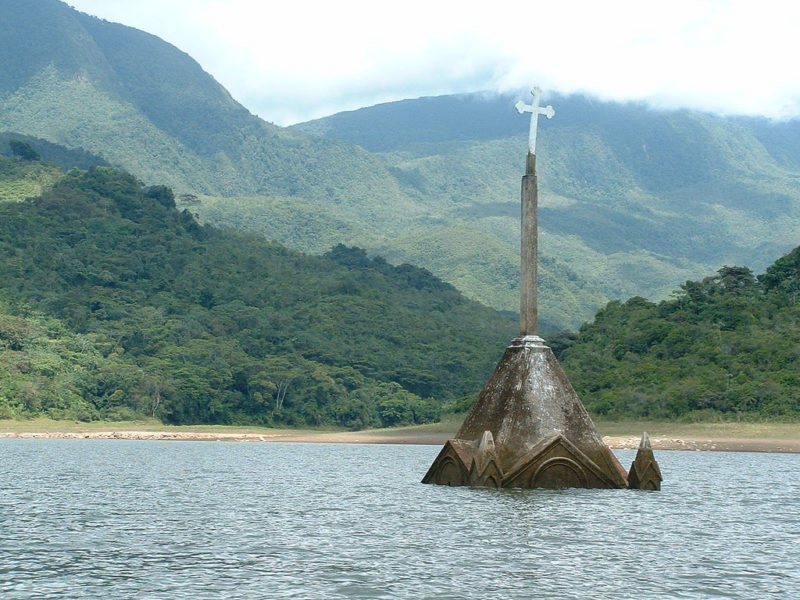
POTOSÍ, TÁCHIRA, VENEZUELA
In 1985, the residents of sleepy, bucolic Potosí received some unwelcome news: The government intended to flood their entire town in order to create the Uribante Caparo hydroelectric dam. The evacuation order came swiftly, and residents were relocated to nearby towns. The dam was completed and the town was submerged, but not all of Potosí disappeared quite so willingly. At low tide, the cross at the top of 82-foot-tall (25 m) church spire would emerge from the water, a reminder of Potosí’s former existence.
In early 2010, the El Niño weather phenomenon caused droughts across Venezuela and the water behind the Potosí dam gradually dried up, revealing the church in its entirety for the first time since flooding.
The site began to attract visitors and, with the area’s water stores reaching critically low levels, locals gathered at the church to hold a mass and pray for rain. Their wish was granted—the skies opened and the Potosí church disappeared beneath the water once again.
Potosí is a 7-hour drive east of Caracas, the capital. The church steeple is now visible to varying degrees, according to rainfall and dam levels—check ahead.
N 8.966666 W 63.550000
4. Akodessewa Fetish Market

LOMÉ, MARITIME, TOGO
When troubled by illness, relationship problems, or financial woes, voodoo practitioners in the West African nation of Togo go to the fetish market of Akodessewa. Located in the capital city of Lomé, the market has a row of tables piled high with dog heads, elephant feet, chimpanzee paws, desiccated cobras, and gorilla skulls. These are all fetishes, or talismans: objects infused with the power of the divine that are used to heal and protect.
Togo and neighboring Benin are where voodoo, known locally as vodun, began. Today, about half of Togo’s population continues to hold indigenous animist beliefs. The fetish market, which is suffused with the smell of decaying flesh, is a sort of al fresco pharmacy, the perfect place to stock up on ingredients for rituals.
Tourists are welcome to peruse the offerings and visit one of the traditional healers in the huts behind the tables. During one of these consultations, the voodoo priest or priestess will ask you to describe your ailment, then consult with the gods to determine your prescription. Animal parts are ground up with herbs and held to a fire, which produces a black powder. Traditionally, a healer will keep consulting with the gods until you reach a mutually agreeable fee.
The market is located in the suburb of Akodessewa, just east of Lomé’s airport.
N 6.137778 E 1.212500
5. Great Mosque of Djenné
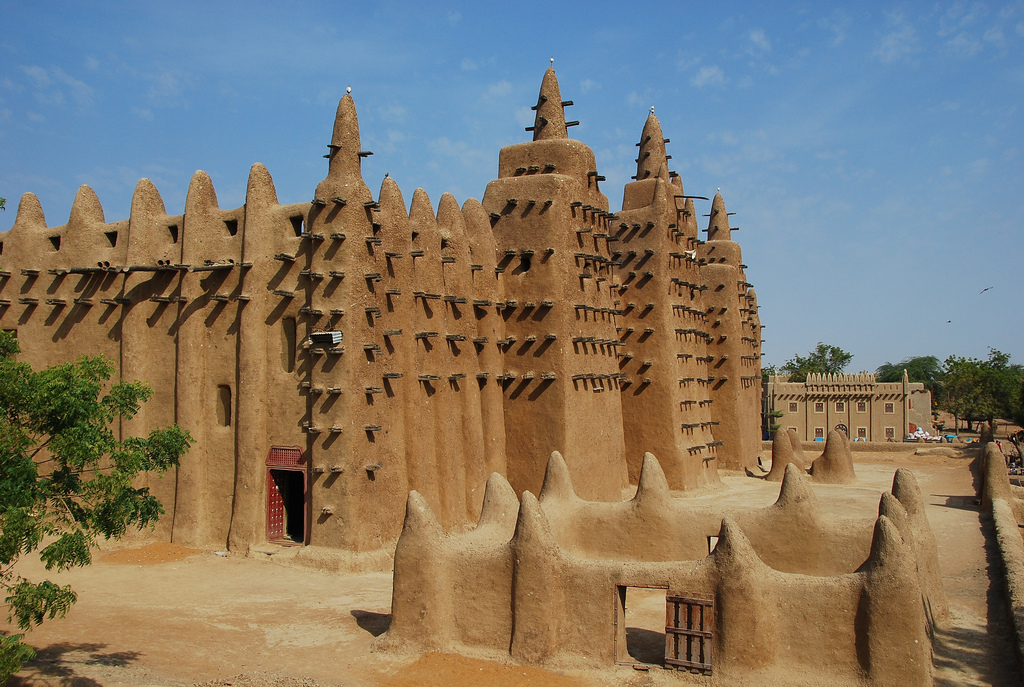
DJENNÉ, MOPTI, MALI
In 2014, the UNESCO Heritage–listed Great Mosque of Djenné sustained damage to its walls and had to be repaired by members of the community. But that wasn’t cause for concern—it happens every year.
Like hundreds of other buildings in Djenné, the Great Mosque is made of mud. It was built in 1907, but the town’s packed-mud architectural style dates back to at least the 14th century. To create the buildings, masons form mud and straw into bricks, allow them to dry in the sun, and stack them to form walls. A layer of mud plastered on top provides a smooth surface and better stability.
Though the buildings are sturdy and often sprawling—the Great Mosque can hold 3,000 worshippers—they are still vulnerable to the elements. Rain, humidity, and temperature changes cause cracks and erosion in the walls. Djenné’s mud masons regularly band together and repair the mosque to keep it from falling apart.
Djenné is an 8-hour drive from Bamako, including a ferry ride across the Bani River.
N 13.905278 W 4.555556
6. Wang Saen Suk Hell Garden
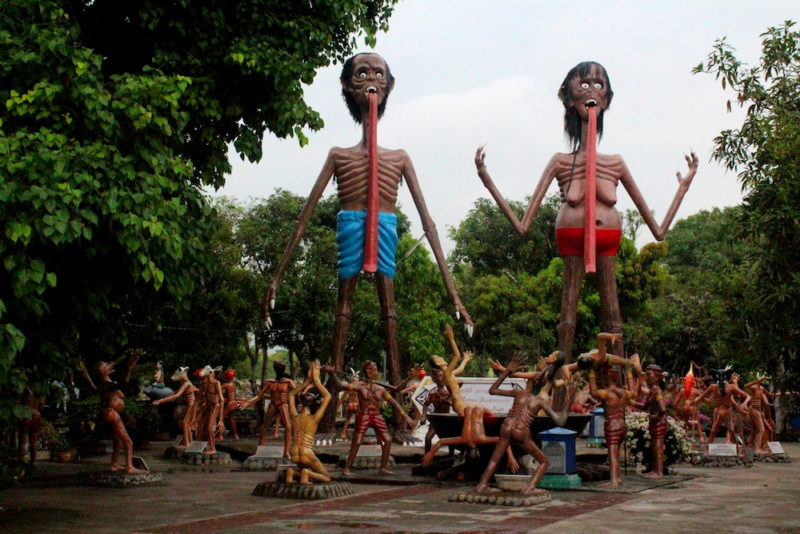
CHON BURI, THAILAND
There’s an awful lot of blood at Wang Saen Suk. It spurts from the mouths of the people being stabbed, gushes from the torso of the man being sawn in half, and bursts from the abdomen of the woman whose baby is being torn out of her body.
These gruesome scenes are sculptures created to decorate a Buddhist “hell garden” that shows what happens to those who behave badly. Buddhists believe in 16 main hells—eight hot and eight cold, all stacked on top of each other. Each hell is dedicated to specific offenses, and the punishments are tailored to the crimes.
The garden’s focal point is an emaciated couple—one male, one female, each 30 feet (9 m) tall with ribs protruding, eyes bulging from exaggerated hollows, and tongues stretched to reach their hips. Surrounding the pair are figures in distress from an array of violent attacks. Some are having their heads eaten by dogs, while others stand helplessly as stern-faced men strip the skin from their bodies, revealing the glistening red layers beneath.
The garden is a popular destination for family day trips.
Sai 2, Soi 19, Saen Suk, Chon Buri. The garden is about 2 hours southeast of Bangkok.
N 13.297022 E 100.910107
7. Funeral Rites of Tana Toraja
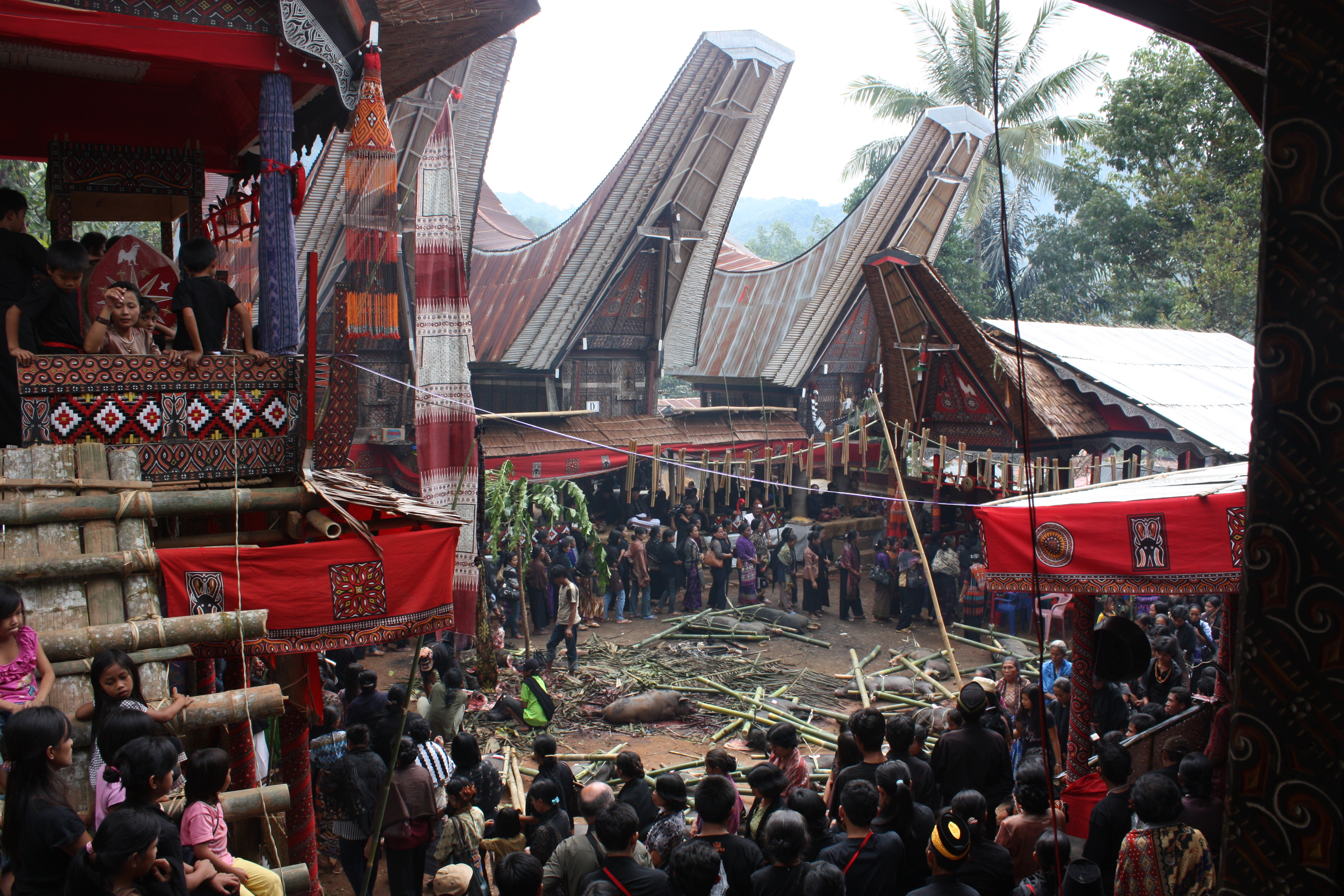
TANA TORAJA, SOUTH SULAWESI, INDONESIA
To the 650,000 Torajans of South Sulawesi, death is not the abrupt cessation of life, but a many-stage process that begins with a stopped heart and ends—sometimes years later—with burial.
The funeral rites of Tana Toraja consist of elaborate, multiday public ceremonies involving animal sacrifices, feasting, gift-giving, music, and a procession of village members toward the burial site. Wooden effigies, or tau tau, of the deceased are created and placed by the graves.
The cost of organizing and staging these rituals is so high that families may spend weeks, months, or even years raising the necessary funds. During this time, the wrapped corpse, chemically preserved with formalin, is kept in the ancestral home and referred to as “sick” or “asleep” rather than “deceased.”
When there is enough money to purchase a herd of sacrificial buffalo, the festivities begin. On the first day, guests form a procession and offer gifts of food, drink, and sacrificial cattle or pigs to the family. The presents are given on an implicit quid pro quo basis—each gift is registered and announced to the crowd, allowing the villagers to keep track of debts paid or incurred.
Later in the week, an animal handler ushers each buffalo to the center of a ring and fastens a rope from its nose ring to a bamboo pole driven into the ground. As adults, children, and family pets look on, the handler raises a machete and drives it into the animal’s neck, creating a gaping wound that gushes blood. The buffalo thrashes and writhes, blood spraying more forcefully with each movement. Gradually, the buffalo loses strength and collapses, dying in a pool of blood and mud. This process is repeated with dozens of buffalo and pigs.
According to Toraja belief, animal sacrifices prevent the spirit of the dead from lingering and bringing bad luck—souls travel to the afterlife on the backs of the buffalo. Back in the earthly realm, raw meat from the animal carcasses is distributed to guests, with high-ranking and wealthy people receiving the best cuts.
A week after the sacrificial ceremonies, the entire village parades the coffin to a burial site. The final resting place for a Torajan is usually a carved hole on the side of a cliff. Popular burial cliffs have rows of caskets guarded by tau tau.
The bus from Makassar, capital of South Sulawesi, takes 8 to 10 hours to reach Tana Toraja. Peak funeral season is after the harvest, from July to October. Ceremonies are public, and it is customary for visitors to bring a small gift for the family, such as coffee or cigarettes.
S 3.075300 E 119.742604
8. Hanging Temple of Hengshan
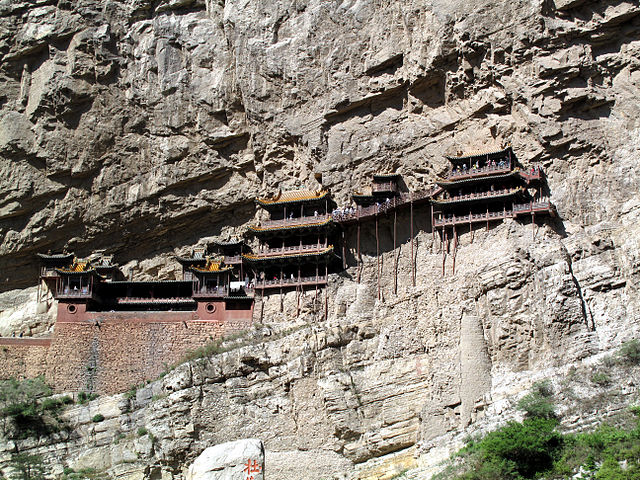
MOUNT HENG, SHANXI, CHINA
Two hundred and forty-six feet (75 m) above ground, supported by a few thin wooden stilts driven into the cliff face, the Hanging Temple of Mount Heng dangles in apparent defiance of gravity. Built into the rock during the Northern Wei Dynasty (386–534 CE), the 40-room temple, connected by a dizzying maze of passageways, has survived the erosive effects of wind, sun, and snow due to its protected position.
Unusually, the temple caters to not one but three religions—elements of Confucianism, Taoism, and Buddhism are evident in its 78 statues and carvings.
Mount Heng is 2 hours southeast of Datong, where you can hire a driver to take you there and back.
N 39.673888 E 113.735555”
9. St. George’s Monastery
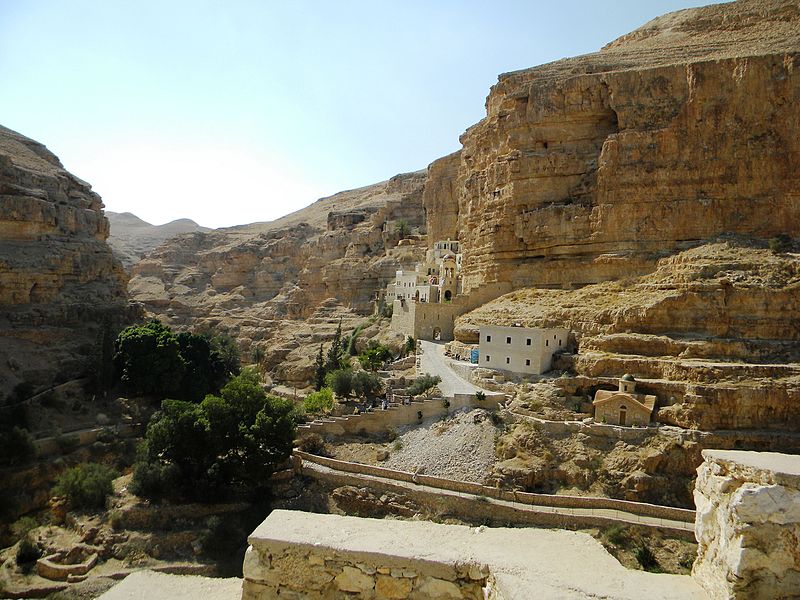
WEST BANK, PALESTINE
Clinging to a cliff on the edge of the Wadi Qelt gorge is a Greek Orthodox monastery that’s endured many centuries of turmoil and destruction.
The original monastery was founded in the 5th century by a group of cave-dwelling hermits. They chose the site because it was located next to the cave where the prophet Elijah is said to have been fed by ravens during the 9th century BCE.
A Persian invasion in the 7th century drove out the hermits and left the monastery in ruins. Around 500 years later, Crusaders rebuilt St. George’s, only to be driven from the site following the Islamic re-conquest of Jerusalem.
The late 19th century saw St. George’s restored once again. The monastery is now home to two churches, a small group of Greek Orthodox monks, and the tombs of the five hermits who got the whole thing started.
A 15-minute drive from St. George’s is the Mount of Temptation—so named because, according to the Bible, it is the place where Jesus was tempted by the devil. This mountain has its own cliffside monastery, established in the 6th century, which has only a single permanent resident. There is also a nearby collection of hermit caves—some of which are said to still occasionally be inhabited by ascetic monks.
Wadi Qelt, West Bank. St. George’s is a 20-minute drive from Jerusalem, followed by a 15-minute hike or short camel ride.
N 31.844452 E 35.414085
10. Underground Temples of Damanhur
BALDISSERO CANAVESE, PIEDMONT, ITALY
From 1978 to 1992, members of the Damanhur commune dug into the mountain where they lived, tapping into what they believed were energy lines connecting the Earth to the cosmos. Their excavations were done in secret: Having neglected to secure planning approval, they had to conceal their work from authorities. But the world would eventually find out.
Led by philosopher, writer, and painter Oberto Airaudi, the “eco-society” of Damanhur began in 1975 with about 24 members. Billing itself as a “laboratory for the future of humanity,” Damanhur is based on neo-pagan and New Age beliefs with emphasis on creative expression, meditation, and spiritual healing. Residents adopt animal and plant names (such as “Sparrow Pinecone”) and live in “nucleo-communities” of 20 people in the foothills of the Alps, 30 miles (50 km) north of Turin.
Some former members have railed against Damanhur’s sunny-spirited collective, describing it as a cult. It was an ex-Damanhurian who tipped off police about the unauthorized underground construction. When three officers and a public prosecutor arrived to conduct an early-morning raid, they were astonished. Beneath a humble farmhouse, behind a secret door, was a collection of temples spanning five levels.
Damanhur citizens had spent a decade and a half working around the clock in shifts to excavate 8,500 cubic meters of earth and rock. They decorated each hall and hallway in a different theme, with murals, stained glass windows, mirrors, and mosaics. The New Age, 1970s-style artwork depicts everything from the history of the universe to a forest of endangered animals to the International Space Station. The perimeter of one of the circular rooms is cluttered with sculptures, due to the directive that each member of the community must carve a statue in their own likeness.
Boggled by the unexpected beauty of the subterranean halls, Italian police granted a retro-active construction permit. The eco-society, which currently numbers around 1,000 members, now welcomes visitors to its temples.
Via Pramarzo, 3 Baldissero Canavese.
N 45.417763 E 7.748451”
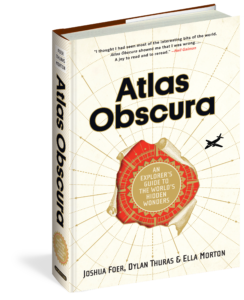 About the Book
About the Book
It’s time to get off the beaten path. Inspiring equal parts wonder and wanderlust, Atlas Obscura celebrates over 700 of the strangest and most curious places in the world.
Created by Joshua Foer, Dylan Thuras and Ella Morton, Atlas Obscura revels in the weird, the unexpected, the overlooked, the hidden and the mysterious. Every page expands our sense of how strange and marvelous the world really is. And with its compelling descriptions, hundreds of photographs, surprising charts, maps for every region of the world, it is a book to enter anywhere, and will be as appealing to the armchair traveler as the die-hard adventurer.
Anyone can be a tourist. Atlas Obscura is for the explorer.
Order Atlas Obscura today!
Amazon | Barnes & Noble | IndieBound | Workman

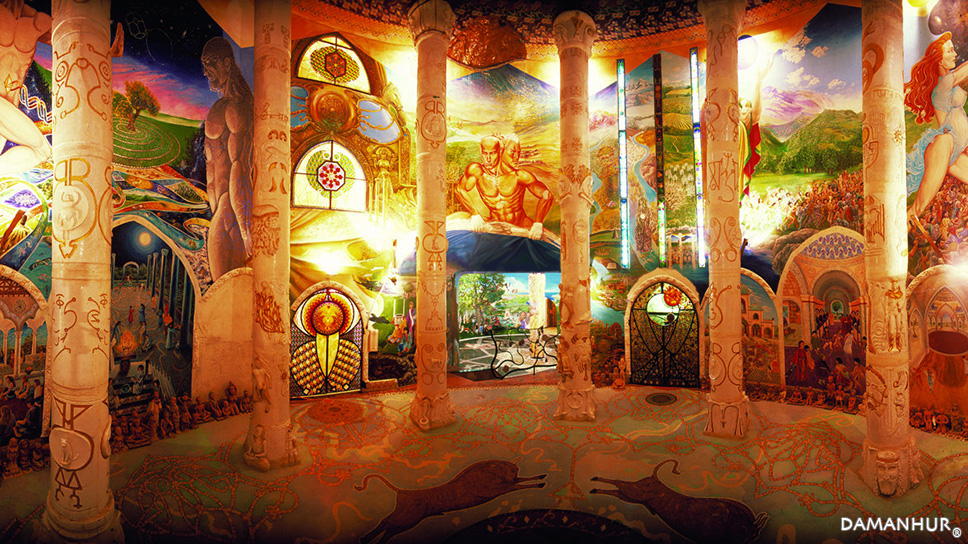
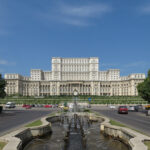



No Comments